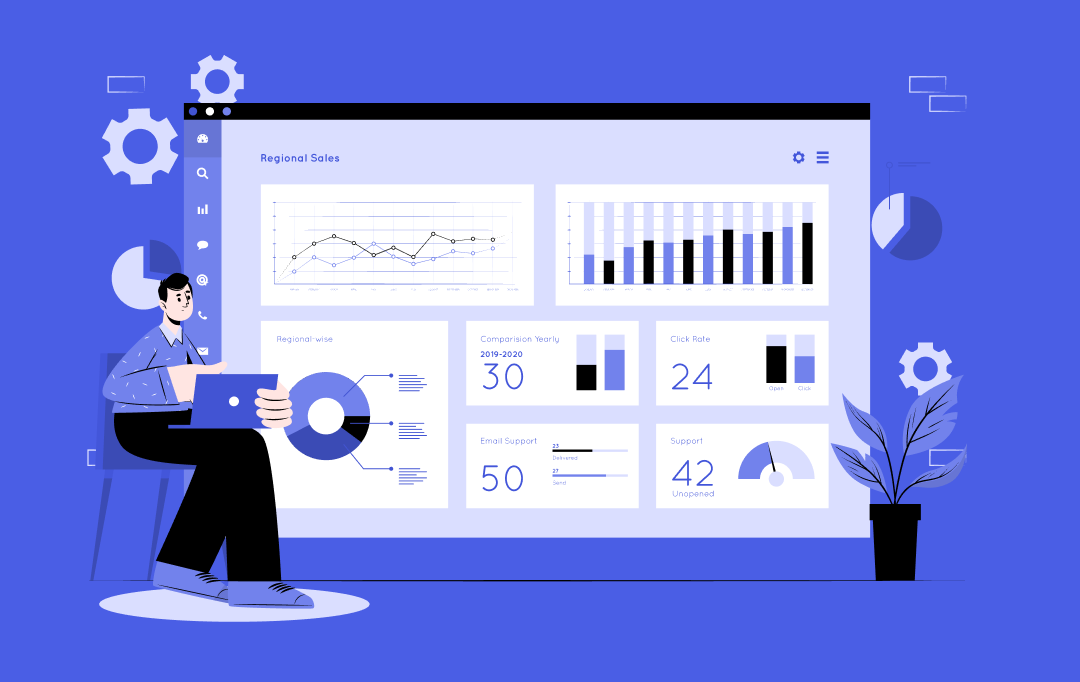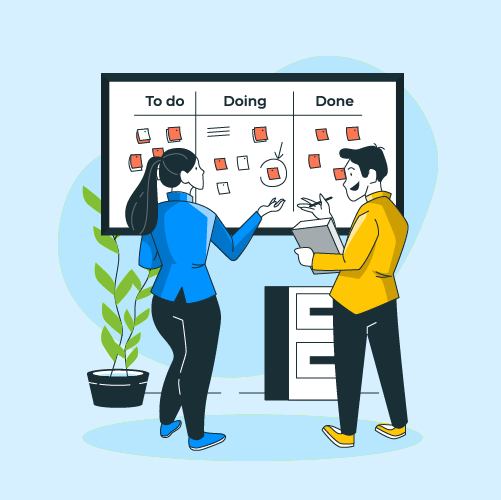- What is Product Backlog in Scrum?
- How Product Backlog Journey Starts?
- How Product Backlog and Product Roadmaps are Different?
- Product Backlog Prioritization Techniques
- Benefits of Product Backlog
- Backlog as Placeholders
- Dynamic Nature
- Easy removal
- Add a backlog item
- Agile Product Backlog vs. Sprint Backlog- A Detailed Difference
- Time To Build Your Backlog
Have you ever had the feeling that your team makes the same mistakes again and over? You believe things are not progressing correctly, and you need to make some changes to improve the project development process.
A product backlog here can help a team decide what they’re working on and what they want to focus on. It’s a description of how the team will carry out the idea laid out in an agile roadmap. It’s a gigantic to-do list for your development team in many ways.
Projects can be part of larger products with a product backlog to manage them. A Product backlog example can be customer implementation projects, which may be delivered as part of a bigger product backlog. Alternatively, a game production studio could treat each generation of a game as a separate project with a set deadline (for example around Christmas).
What is Product Backlog in Scrum?
In Scrum, the agile product backlog is a prioritized features list that includes brief descriptions of all product functionality. If you are working on a project then it is not required to begin it with a lengthy effort to document all requirements using Scrum. A Scrum team and its product owner can start by including anything they can think of for agile backlog prioritization.
This agile product backlog is more than enough for a first sprint. As additional information about the product and its customers becomes available, the Scrum product backlog permits it to expand and adapt.
In Scrum, the product backlog is a prioritized features list that includes brief descriptions of all product functionality. It is not required to begin a project with a lengthy, upfront effort to document all requirements while using Scrum.
In custom software development services, a scrum team and its product owner typically start by jotting down anything they can think of for agile backlog prioritization. Almost always, this agile product backlog is more than enough for a first sprint. As additional information about the product and its customers becomes available, the Scrum product backlog is permitted to expand and adapt.
How Product Backlog Journey Starts?
First comes the vision or an idea, then the strategy takes place, to accomplish the idea there is a need for the roadmap, and after laying the roadmap comes the product backlog. Below given pointers show what each of the product backlog journey terms mean.

- The product strategy is an outline of how the company’s goal will be realized at a high level
- The product roadmap dictates the plan to be carried
- The product backlog contains the task-level specifics required to produce the pro product
How Product Backlog and Product Roadmaps are Different?
The two key product management tools are the product roadmap and the product backlog. Each instrument has its own set of advantages and disadvantages. A product backlog should not be confused with a product roadmap. Both of these living documents are useful for agile development process teams for different reasons. The backlog provides tactical development specifics, whereas the roadmap concentrates on the overall strategy.

Product backlog management entails a variety of tasks and strategies. Because the product roadmap is frequently changed, it must be closely linked to the product backlog. As a result, the backlog must be prioritized (and re-prioritized) regularly to reflect changes and discoveries.
The product backlog includes epics and user stories, workflow diagrams, user-interface design sketches, and mock-ups, as well as other outstanding work required to construct a product. It’s a tactical tool that guides the development team’s work and serves as the foundation for tracking development progress with tools like a release burndown chart. The primary distinctions between the product roadmap and the product backlog are summarised in the diagram below.
The product roadmap is a strategic product-planning tool that outlines how the product will evolve over the following time. It establishes a sense of purpose, encourages stakeholder participation, aids in the acquisition of funds, and makes it easier to coordinate the development and launch of various products.
Additionally, special attention should be paid to keep the backlog structured and accessible. The product backlog management practices recommend aiming for a Detailed appropriately, Emergent, Estimated, and Prioritized (DEEP) product backlog in which the items with the highest priority contain the most detail, and the level of detail reduces as the priority increases.
Most agile teams also participate in product backlog grooming sessions, which are used to refine and arrange backlog items. During these meetings, the team collaborates to plan ahead of time for a few sprints’ worth of user stories. Agile backlog grooming sessions guarantee that the user stories at the top of the backlog have enough detail to be understood by the delivery team.
Product Backlog Prioritization Techniques
- Rather than being a one-time event, product backlog grooming is a continual process involving product owners and development teams. Subject expertise is often present in development teams, which they can refine. The Scrum team, on the other hand, determines when and how the optimization will be completed.
- The act of adding detail, estimations, and order to items in the Product Backlog is known as product backlog refinement. Within each Sprint, ongoing Product Backlog Refinement is required to refine products so that they are ready for future Sprints. Refinement of the product backlog typically requires no more than 10% of the development team’s work.
- The product backlog items at the top of the Product Backlog (highest priority, biggest value) are decomposed so that they fit within one Sprint once the backlog items have been refined to the appropriate level of granularity.

All estimation work is handled by the development team. By assisting the team in assessing trade-offs, product owners can have an impact on their decisions. The person doing the task, on the other hand, determines the final estimate.
Benefits of Product Backlog
Backlog as Placeholders
Backlog items serve as placeholders for future discussions regarding a solution for reaching your goal. This means that a team does not need to have a completely developed idea before adding it to the product backlog. When a product backlog item is first introduced, it just needs to have enough information to remind the team what the alternative was. When a team is about to start working on a product backlog item, it just needs to be fully explained.
Dynamic Nature
A product backlog’s dynamic nature allows teams to keep track of their learning about the desired goal and potential delivery methods. The product backlog does not have to be complete when a team begins working. Thus, they can begin with an original concept and add new product backlog items as they gain experience.
Easy removal
Just because something is in a product backlog doesn’t mean it has to be delivered. A team can remove items off the backlog if they don’t contribute to the desired end. This means that a team can avoid producing non-value-adding deliverables and instead focus on making truly useful changes.
Add a backlog item
Product backlog can be used by teams to avoid time waste debating whether an option is valuable or not based on limited information. When a new idea presents itself, the team can add a product backlog item as a reminder to investigate the idea further. The team can then prioritize consideration of that idea alongside other items, and remove the product backlog item if the idea proves to not provide progress toward the desired outcome.
Agile Product Backlog vs. Sprint Backlog- A Detailed Difference
In a nutshell, the sprint backlog is the team’s short-term sprint plan. The product backlog in agile is the product’s long-term plan, in which the vision is categorized into tangible deliverable items that add value to the product. Many people consider the sprint backlog to be a subset of the product backlog. This is ideal; the sprint backlog is made up entirely of items from the product backlog. Also the sprint will typically include other work that the team has committed to and the tasks that can be completed during the product design sprint.
The product backlog in agile is a collection of tasks you expect to complete in the future to maintain your product competitiveness. It is the result of collaboration between the product owner and stakeholders (customers, the team, analysts). It will be updated regularly, with new items being added or removed.
In general, it will be larger than the sprint backlog. It will also include elements with varying levels of granularity, with fewer items broken down below the level of the user story. The product owner is in charge of it.
The sprint backlog is a collection of work that the team is committed to completing, either now or later in the sprint (typically a 1-4 week period). It is made up of user stories that the team has committed to completing during the upcoming sprint.
However, it can also include things like bugs, refactoring work, and so on. It’s usually more detailed and divided out into activities, with the technical implementation of a user story at the forefront. It is the scrum master’s and team’s responsibility.

Time To Build Your Backlog
The need for proper planning and organization is critical to your success. That’s where backlogs come in handy. The backlog, when properly generated and maintained, becomes a tool that aids teams in navigating constant change, achieving peak productivity, and providing maximum value to both the business and the customer.
In the above blog we have described what product backlog is and how it helps a team in their working by creating a common ground for stakeholders and teams to align so that the most meaningful user stories are implemented, allow flexibility to respond to changing demands, and circumstances, create a common denominator across several teams working on the same product to improve the accuracy of product release forecasts.



Product Analytics - Why it Matters and How to Implement it Effectively
You’ve launched a product. The interface is clean, the core features are stable, and early reviews are encouraging. But under the surface, there’s a growing list of questions you can’t quite answer. Which features are driving retention? Why do users drop off halfway through onboarding? What’s the real reason behind those five-star reviews - or…

Exploring the Key Benefits and Use Cases of Digital Twins in Product Development for Enterprises
The major survivor factor is the companies' ability to develop, launch, and enhance the product. McKinsey predicted that - over the next five years, about $30 trillion in corporate revenues will depend upon products that have not yet reached the market. Consumers also need compelling reasons to retain the purchase of your product - advanced…

Best 5 Diagrams Used To Explain Product Management Concepts
There are a lot of things product managers are accountable and responsible for. A product manager is not only liable to strategize by creating a roadmap but also needs to articulate the release cycle of a new product to the team along with everything that comes in between. They are also required to have the…
















